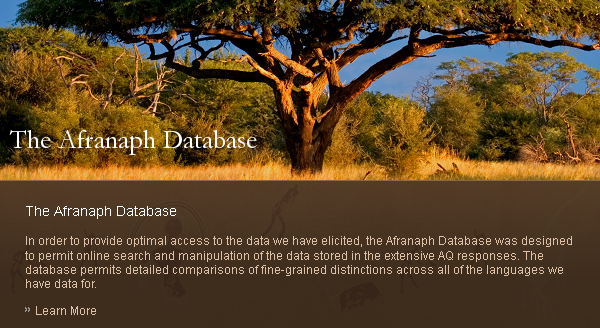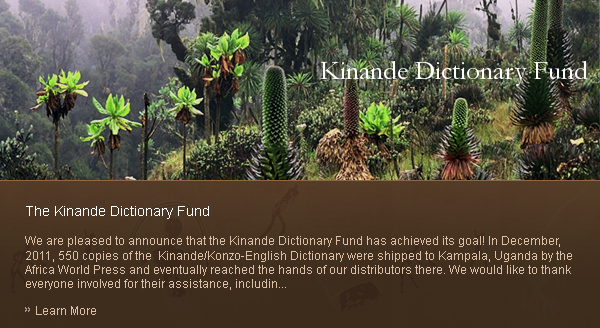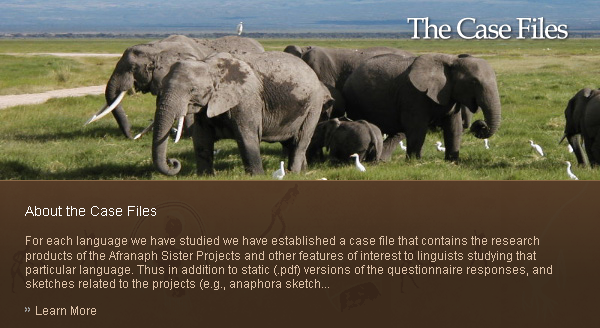- Last Updated on Wednesday, 19 March 2014 09:42
Simple Search
In the database navigation column on the left, click on Simple Search. At the top of the Simple Search page, there is a heading in a green box labeled Search for and below it are three options which are the names of the entities that can be searched for: Languages, anaphoric markers, and sentences. This means that if you specify at the top of the page that you are searching for sentences of a certain type, then the result of the search is a set of sentences, but if you specify that you are searching for anaphoric markers of a certain type, then the result of the search will be a set of anaphoric markers, and likewise if you select for languages. The ways that your search can be conducted even for Simple Search are varied, but, we think, intuitively arranged.
Simple searches can be conducted by selecting an entity type and then setting the search parameters below by either specifying some text in the text boxes (‘search by word or substring’) or by clicking on a search parameter. The languages available for simple search are listed first, and if you leave this blank then all the languages available will be searched, but if you want to limit the search to just one language, then click on that language. If you want to search more than one language but not all, click on the first one you want, then hold down the control key and click on another one you want. If you want to ‘unspecify’ a language you have clicked, hold down the control key and click on it again to remove the specification.
If you are going to search for sentences that contain a particular gloss, such as ‘applicative’, which is rendered in our glosses as ‘APPL’, you will need know what our glossing conventions are, and for this go to the Glossing Conventions page.
Let’s do some simple searches.
Simple Search 1: Set the Search for parameter to Anaphoric marker. We are going to look for reciprocal markers. Suppose we want to see all of the morphological strategies in the database that result in reciprocal readings. Since we want to look at everything in the database, we do not specify any language. Since we are not looking for markers that appear in particular sentences, we leave the four lines of text under Sentence blank. For the same reason, we do not specify an anaphora questionnaire (AQ) elicitation sentence number either (more about this in the next simple search). Now we come to the last heading, Anaphoric marker, with two text boxes under it. The first box allows you to specify the name of a strategy and the second one allows you to specify part of the description of the strategy. Let’s try both in turn.
First, just specify the description by typing in ‘reciprocal’. Leave the Name text box empty. Then go to the bottom of the page and click on the Search button. What comes up is a list of all of the reciprocal markers from all of the languages in the database that have the word ‘reciprocal’ as part of their description. Notice that the same name may be applied to the anaphoric marker in several languages, but there is separate heading for that name for each language where it occurs. This is because every time we enter a new anaphoric marker for any given language it gets a new ID# which distinguishes it from every other marker.
Now try a search by marker name. You will notice from our first search that many reciprocals are named ‘RCM’, which comes from our glossing convention for reciprocal readings that are marked by virtue of an affix on the verb. If ‘anaphoric marker’ is selected under Search for and you type in ‘RCM’ in the Name text box under Anaphoric marker, leaving all other specifications blank, and if you then click on Search, the result is another set of markers, this one smaller than the last set, but it has a list of all of the anaphoric strategies that use a verbal reciprocal affix across all the languages of the database.
As it happens, the reciprocal affix in almost any Bantu language is cognate to all the others. This is something that you would discover if you first do a simple search for the anaphoric marker name ‘RCM’, and then isolate all the Bantu languages, but the specification for language family is an Enhanced Search page feature, and so the only way you can do this for a simple search is to specify all the languages you know to be Bantu under the Language heading and the markers from only those languages will be gathered in the search. If you wanted to limit your search to only those languages with a particular word order, that would also require an enhanced search, where language properties can be specified for.
Simple Search 2: Now lets search for a set of sentences. Suppose we want a close comparison of all the sentences across all the languages that were elicited by a particular sentence that appears in the AQ. Suppose that sentence is (C13d), ‘Nick put his book on the table’(where ‘his’=’Nick’). Below the Sentence heading, under the four text lines for sentence searches, there is a subheading Prompt sentence, and below it a list of the elicitation (prompt) sentences from the AQ listed (for the most part) in the order that they appear in the AQ. Only the first six sentences appear in the window, so simply scroll down until you get to (C13d), then click on it. Then press the search button.
The sentences that come up are from all of the languages that we have a translation of this sentence for. For some languages, there will be more than one example corresponding to (C13d) because the consultant tried out more than one way of translating the elicitation sentence. You will notice that all of the sentences that are acceptable are marked ‘(ok)’, and those that are not acceptable are marked (*) or some combination of stars and question marks that indicates the degree of degraded acceptability. Life being what it is, many examples will not have all four sentence lines entered, as many will lack the ‘original text’ line (perhaps the least crucial for syntacticians, but we are trying to improve our data collection in this regard).
It is important to realize that not every sentence can be searched for by prompt sentence #, since many sentences volunteered by our consultants were not based on elicitation models, and much follow-up work involved the elicitation of data that was not initially requested in the AQ. Still, prompt sentence elicitations provide close comparisons where they are available and where the consultant responds with a sentence that is as close to the prompt sentence as possible.
Simple Search 3: Suppose we would like to know if there are any sentences in any language in the database that ever permit both a RCM and a RFM (verbal affix reflexive marker) in the same sentence. For most analyses of Bantu languages which have both a RCM and a RFM, it is generally assumed that the affixes are mutually incompatible. This search should come up empty, even if we do it right. So how do we do it?We have to be a little creative for this search. The problem is that the gloss line searches are weakly conjunctive, that is, if we enter ‘RCM, RFM’ in the gloss line or ‘RCM RFM’, then we will get all the sentences that have either affix or both, and this is a very long list. However, since ‘RCM’ and ‘RFM’ figure both as glosses and as names of strategies, we can search for the combination sentences by entering ‘RCM’ in the gloss line and ‘RFM’ in the marker name line. Then hit Search.
The result will be a list of sentences that use both a RFM and a RCM in the same sentence. The result of my search today (November, 2008) provides 16 examples, all but one from Lubuksu, and all with both affixes on the same verb. What we really want to see is whether or not the RFM and the RCM are ever attached to the same verb, but it is conceivable that this search could have called up a complex sentence with a subordinate clause or two, where the RCM could have been on a different verb from the RFM; fortuitously, it appears there are no such sentences in the database just now. Still, we have made a surprising discovery - at least in Ikalanga (one example) and Lubukusu, these affixes are not in complementary distribution.
Limitations of Simple Search: Suppose you are interested in anaphoric strategies as they apply to verbs that tend to be understood reflexively when they are intransitive, such as English ‘wash’, ‘dress’ or ‘shave’. Many languages have distinct strategies for forming reflexive readings for these verbs, as English does, insofar as verbs like ‘kill’, ‘describe’ and ‘cut’ do not permit the same strategy. How would we look for just this class of verbs to see what distinctions might arise? A simple search could enter ‘wash’, ‘dress’ and ‘shave’ in the gloss line, and if you try it with simple search, much of what we are looking for will come up. Still, there may be more such ‘grooming’ verbs than one can think of offhand, and some languages may have grooming verbs that don’t correspond to the English ones. Wouldn’t it be convenient to simply limit your search to sentences with grooming verbs? Or suppose you are interested in perception verbs or epistemic verbs? In fact, the database is coded for these properties of sentences (semantic class of main verb), and for a host of other sentence properties, but unless you try out Enhanced Search, you will not be able to exploit the full potential of the database, which also codes for the anaphoric marker and language properties that you saw when you looked at the Browse page for the language of your choice. It’s time to explore the Enhanced Search page.






